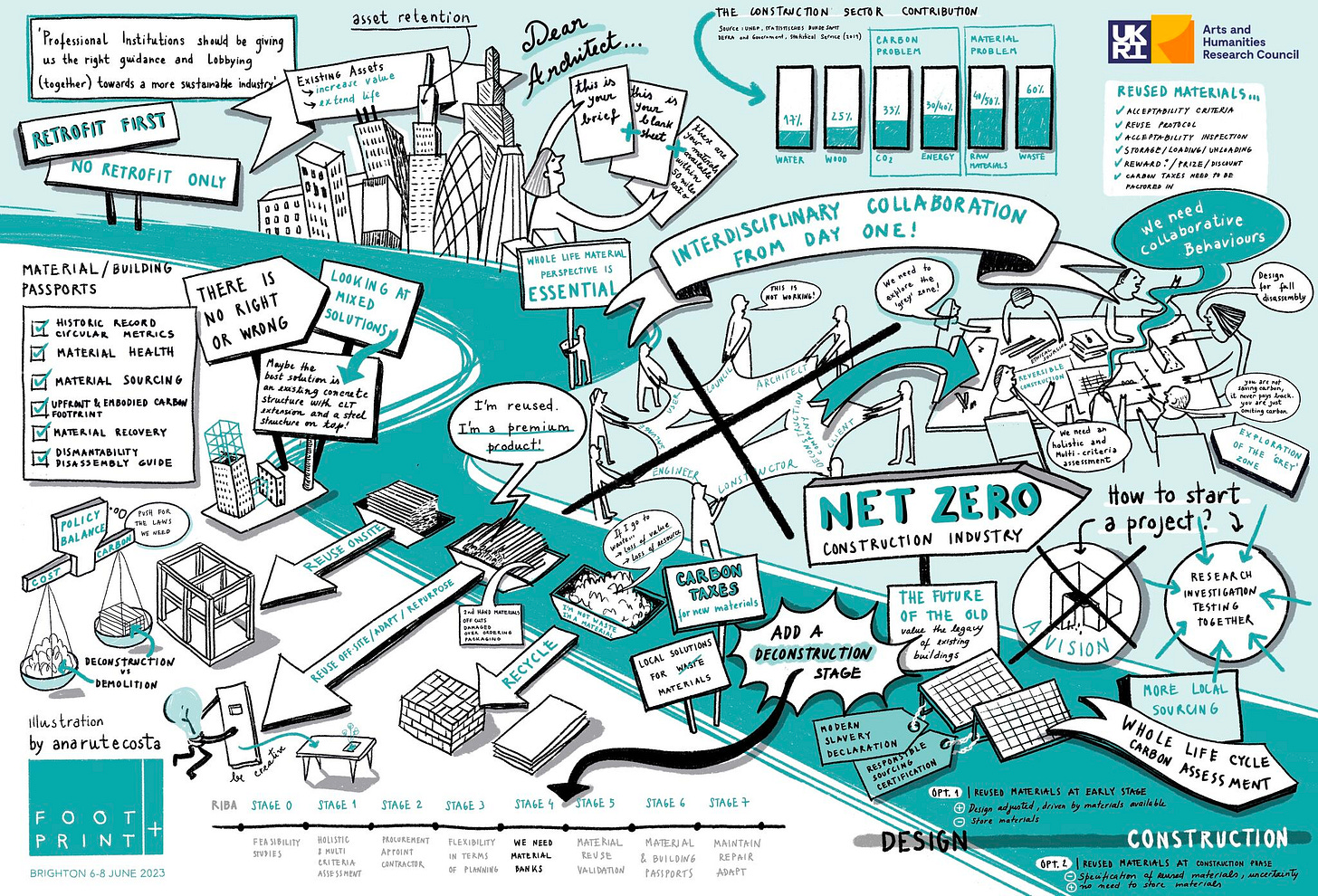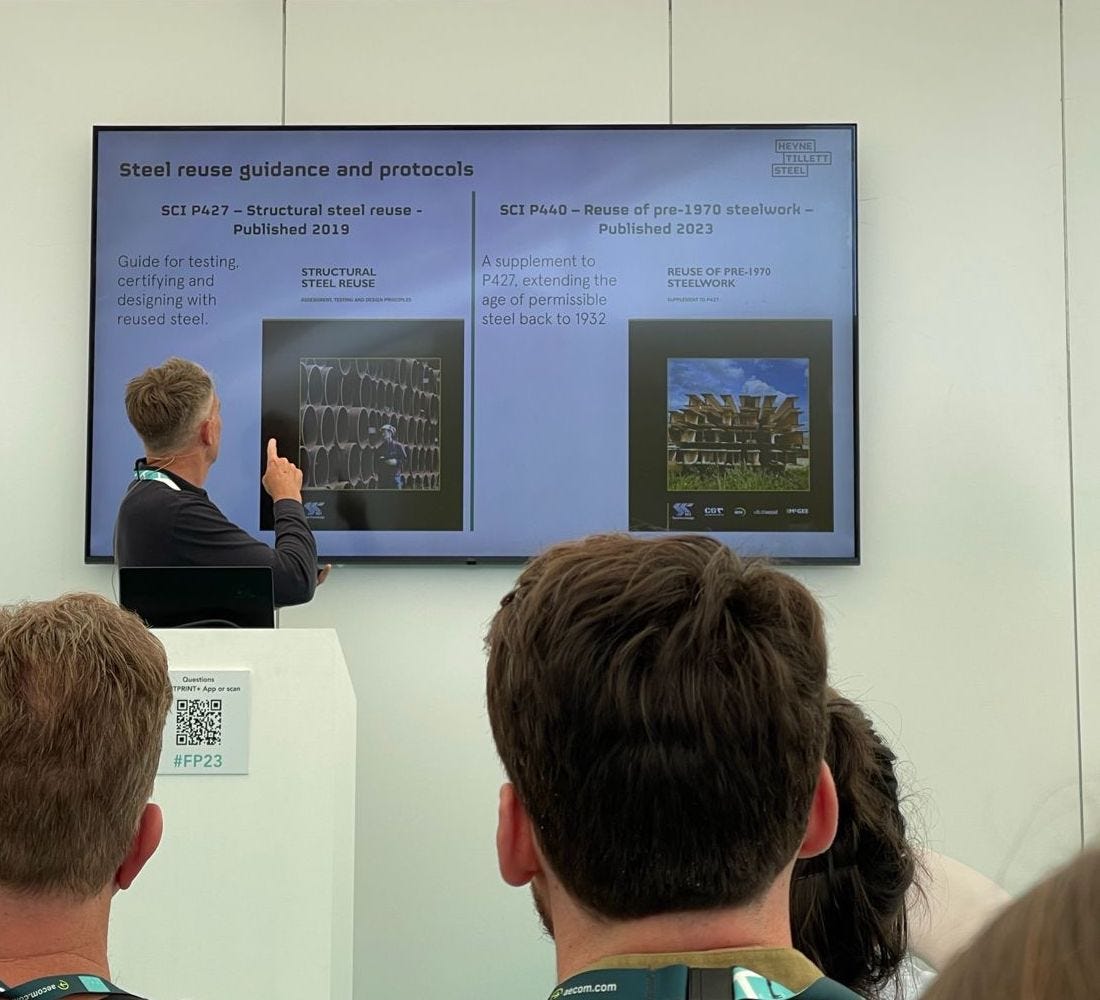FOOTPRINT+
3 days wrapped into one graphic
I attended Footprint+ for the second year running. Last year, I was able to be there for two days (see 2022 write ups 1 and 2), however this year I had to cut things short to just the first day and was a little pre-occupied trying to work in the background and also sit on a panel about talking about steel (of course!).
So I’m very grateful that Ana Rute Costa has allowed me to share her infographic that tells you all about the event 🤓
Ana’s Amazing Summary
I saw this brilliant image being shared on LinkedIn and asked Ana if I could share it further via the newsletter. Ana agreed, and also provided the following summary of Footprint+ in her words:
Footprint+ conference brought together different stakeholders across Architecture, engineering and construction industry to discuss sustainable solutions for the build environment. During the three days, participants were able to ‘seat around the same table’ share not only best practices but also pitfalls, experiences and learning journeys.
We are all doing our best to tackle climate emergency and meet net zero targets, however if we join forces, maximise efforts, share knowledge, network and generate synergies that allow us to learn from each other and move on the right direction.
This graphic visualisation comes from an interest on accelerating material reuse in construction through the use of material passports. Myself and Orms Architects, are currently working on policy paper funded by AHRC-UKRI on the same topic that will be launched in November 2023.
I did manage to watch (and participate in) a couple of presentations myself…
NABERS UK
I listened to a useful discussion on NABERS UK and it was reinforced that a key indicator this this is gaining traction is the fact that BCO recently published guidance on this (see previous newsletter": BCO Key Criteria). The industry seems to widely agree that this rating scheme represents a key tool in driving the NZC transition.
Sarah Ratcliffe, CEO, Better Buildings Partnership explained the shortcomings of other ratings schemes and the way we typically design for a ‘compliant approach’. NABERS UK changes this and looks to close the big performance gap we often have between design and reality. It’s all about measuring the outcomes she says, stating we need:
Performance Metrics
Visibility & Transparency
Accountability
Sarah also explained that NABERS UK can work for all buildings, not just new projects. It splits into two parts: 1) “Design for Performance” (new build), and 2) “Energy” (existing office). And in case you were wondering there is a 6 star rating system, with 6 being market leading and 5 is only excellent.
I got the sense that the current push is to educate people that the scheme can and should be applied to existing buildings - I can understand why many might think this only applies to new build development projects.
And the big sell… it was described as a “investment grade rating” because it proves the performance as well as the design. Like it 💰
A couple of other points came out in the Q&A from the other panelists (Malcolm Hanna, Peter Williams, Amrita Dasgupta Shekhar):
Malcolm likes the fact it keeps the operational team focused on retaining stars throughout the in use period
Peter thinks designers and contractors are familiar with designing and building, but not operating. Therefore there is still a disconnect and we need to focus on the soft landing.
Peter said something we all know but is absolutely key to this - good Building Managers are like gold dust but crucial to maintaining performance
Should NABERS UK be embedded into building regs? In AUS, this is the case and requires mandatory disclosure. Sarah - we need policy focused on outcomes rather than intent. But yes, it’s possible. Malcom - we need transparency. Peter - the industry is leading government and just ‘getting on with it’
It was explained that BBP are working on a green lease toolkit in AUS, which will help embed NABERS UK into leasing. I guess we should look out for that here soon too.
Apparently the scheme gives better delineation between roles and responsibility, so hopefully we can avoid the old school situation of every blaming each other!
When it comes to existing buildings and the capex needed to achieve NABERS UK Peter said he believes sustainable and environmental policies are enabling this across all buildings.
Re-use of steel in practice
I won’t bang on about steel much here, but just to say that Tom Steel (HTS), Roy Fishwick (CST), Paul Moody (Cantillon) and I spoke about what is happening in the steel reuse space and HTS launched their Stockmatcher - a selection tool built to assist procurement of reclaimed steel for use in new construction projects. It is free to use and requires no licenced software… definitely have a look!








